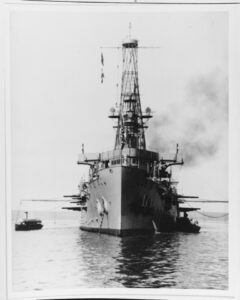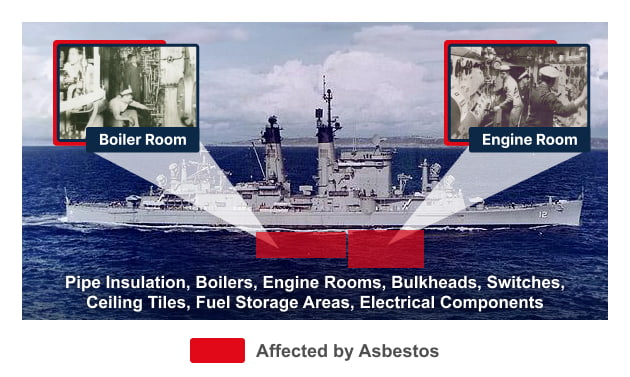Asbestos-containing products were used on a daily basis by sailors operating on cruisers. As these materials broke down, asbestos fibers became airborne, exposing Navy personnel. Asbestos use on cruisers has been linked to a number of health conditions, including asbestosis, lung cancer, and mesothelioma.
Did Cruisers Contain Asbestos?
Yes, hundreds of U.S. Navy cruisers used between World War II and up through the Cold War contained asbestos.

This put many Navy veterans at risk of developing deadly cancers like mesothelioma.
Thankfully, veterans with mesothelioma can receive benefits from the U.S. Department of Veterans Affairs (VA) to access monthly payouts and medical care.
They can also pursue asbestos claims from the makers of asbestos-containing products.
Get a Free Veterans Packet to learn about these options.
List of Navy Cruisers With Asbestos
Asbestos was used in shipbuilding for years, which is why so many Navy vessels previously contained this harmful product.
- USS Albany
- USS Astoria
- USS Baltimore
- USS Boston
- USS Canberra
- USS Columbus
- USS Helena
- USS Houston
- USS Jouett
- USS Juneau
- USS Los Angeles
- USS New Orleans
- USS Norfolk
- USS Pittsburgh
- USS Quincy
- USS San Diego
- USS San Francisco
- USS St. Paul
- USS Vicksburg
- USS Wilkes-Barre
The list of cruisers above is not complete. Any Navy cruiser built before the 1980s may have contained asbestos.
Many types of Navy cruisers contained asbestos on board.
- Anti-Aircraft light cruisers (CLAA)
- Light Cruisers (CL)
- Guided Missile Cruisers that were nuclear-powered (CNG)
- Guided Missile Cruisers with Helicopter capabilities (CGH)
- Guided Missile Cruisers (CG)
- Command Cruisers (CC)
- Large Command Ship (CBC)
- Large Cruisers (CB)
- Guided Missile Heavy Cruisers (CAG)
- Heavy Cruisers (CA)
- Armored Cruisers (CA)
- Cruiser-Hunter Killer Ship (CLK)
- Guided Missile Light Cruiser, Nuclear Powered (CLGN)
- Guided Missile Light Cruiser converted to carry missiles (CLG)
- Command Light Cruisers (CLG)
- Ticonderoga-Class Guided Missile Cruisers (CG)
Further, almost all U.S. Navy ships contained asbestos due to government mandates before the risks were known.
How Was Asbestos Used in Navy Carriers?
From the 1930s to the early 1980s, asbestos was used prominently in cruisers as insulation and in products and machinery.
Asbestos was cheap and versatile, so it was used on many cruisers and ships before it was known that asbestos was dangerous to breathe or ingest.


Asbestos was commonly used in:
- Pipe insulation
- Boilers
- Engine rooms
- Bulkheads
- Switches
- Ceiling tiles
- Fuel storage areas
- Electrical components
As a result, many Navy veterans, including sailors and shipyard workers, were exposed to asbestos and could be at risk of mesothelioma today.
Get a Free Veterans Packet if you were exposed to asbestos on a cruiser and later developed mesothelioma. We may be able to help you secure VA benefits, find top doctors, and retrieve financial compensation.
Asbestos-Containing Products on Cruisers
Documents from Navy logs showed the widespread use of asbestos in all areas of the ship.
Asbestos products and the areas they were used on Navy cruisers include:
- Asbestos cloth insulation for pipe flange cuffs
- Asbestos cloth insulation for valves
- Molded asbestos for lagging and insulation
- Asbestos-containing gaskets
- Asbestos-containing paper
- Packing rings made from asbestos
- Elevator pit drainage pumps
- Auxiliary condenser circulation pumps
- Main boilers and piping
Asbestos was also used to repair and refurbish all of the valves, turbines, condensers, boilers, and gaskets found on these cruisers.
Among those at the highest risk for asbestos exposure are Navy veterans who built cruisers and those who worked in boiler rooms and engine rooms.
This is where asbestos was most prevalent, and there was the greatest need for continually replacing asbestos-containing parts.
Compensation Options for Asbestos on Cruisers
If you were exposed to asbestos while serving on a Navy cruiser and now have mesothelioma, there are several options available to you to seek compensation.
View top mesothelioma compensation options that our team may be able to help you access below.
Mesothelioma VA Benefits
The U.S. Department of Veterans Affairs (VA) offers many benefits to veterans with mesothelioma.
Notable mesothelioma VA benefits include:
- Disability compensation that pays out $4,044.91 monthly
- Free or low-cost VA health care copays
- Survivor benefits for next of kin
The VA typically rates mesothelioma as a 100% disability. This means that veterans can receive the highest monthly compensation and lowest medical care copays through the VA.
Get help filing for or increasing your mesothelioma VA benefits now.
Mesothelioma Lawsuits
You or a veteran who you love may be able to file mesothelioma lawsuits to secure financial compensation. These lawsuits award $1 million or more on average and no legal action is taken against any branch of the military or government.
Our legal partners have secured millions of dollars for other veterans who served aboard cruisers and later developed mesothelioma.
Recent legal settlements for veterans exposed to asbestos on cruisers include:
- $2.98 million to a West Virginia veteran who served on the USS Valley Forge and developed pleural mesothelioma
- $2.44 million for a Wisconsin veteran who was a fire control specialist on the USS Toledo
- $2.19 million for a Minnesota veteran who served on the USS St. Paul as a fireman and machinist and developed peritoneal mesothelioma
- $2.1 million to a boiler tender who served on the USS Wilkes Barre and USS Little Rock
- $2.7 million to a veteran from Arizona who served on the USS Hamul, USS Lea, and USS Duluth as an electrician’s mate
Call (877) 450-8973 to see if you can pursue legal compensation with our help.
Asbestos Trust Funds
Besides lawsuits and VA benefits, you may be eligible for compensation by filing a claim with asbestos trust funds. These trusts were established by companies who filed for bankruptcy to avoid lawsuits.
Over $30 billion is currently available across these trusts, and you may qualify to file claims with multiple trusts.
Help For Veterans Harmed by Asbestos on Cruisers
U.S. veterans didn't deserve to be put at risk of life-threatening diseases like mesothelioma from serving their country. Yet, for veterans exposed to asbestos on cruisers, this exactly the case.
The Mesothelioma Veterans Center stands ready to aid Navy veterans and loved ones who are now fighting this rare and aggressive cancer.
Our team can:
- Assist in filing for or increasing VA benefits
- Connect you with top doctors and hospitals
- Pursue legal compensation to cover your expenses
Get a Free Veterans Packet to explore all of the ways we can help you and your loved ones.
Asbestos on Cruisers FAQs
Do cruise ships have asbestos?
Yes, cruise ships and many other types of U.S. Navy vessels contained asbestos materials before the 1980s, when the harm linked to asbestos was discovered.
Once the danger associated with asbestos was revealed, shipbuilders stopped using the material in shipbuilding and repair.
However, exposure to this toxic material can cause adverse health conditions decades after exposure.
Can asbestos exposure on cruisers lead to cancer?
Yes, exposure to asbestos-containing products on Navy cruisers can lead to the development of a cancer caused solely by asbestos exposure known as mesothelioma.
It could also lead to lung cancer, asbestosis, and other health conditions.
When did asbestos stop being used in boats?
The U.S. military stopped using asbestos in new Navy boats and ships in the early 1980s.
Existing ships were renovated to remove most asbestos-containing materials.
However, for Navy veterans already exposed, there is no way to lower the risk of developing mesothelioma later in life.
What’s the average asbestos settlement for mesothelioma?
The average asbestos settlement is worth $1 million to $1.4 million. You can pursue a legal settlement after a diagnosis without taking legal action against the government or military.
Our team has secured millions of dollars for other veterans who developed mesothelioma after being exposed to asbestos on cruisers.
Call (877) 450-8973 for help pursuing financial compensation for mesothelioma.


